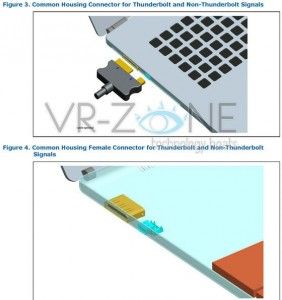 I think it’s going to take me a while to work out the reason why this rather akward and cumbersome looking docking solution port is being considered for Ultrabooks. A common docking standard could be a good move though.
I think it’s going to take me a while to work out the reason why this rather akward and cumbersome looking docking solution port is being considered for Ultrabooks. A common docking standard could be a good move though.
We know already that the 2012 Ultrabook platform will include support for Thunderbolt and that it is going to make a great single-plug docking system given a Thunderbolt station or hub. Ok, the price of the Thunderbolt hub/station or a Thunderbolt monitor is going to be expensive to start with but that price will come down if it is well adopted which it look like it could be. In the meantime we’ll have HDMI to carry the digital a/v and if you want a mouse, the usb port making a maximum of two connectors.
The new solution shown via VR-Zone is a single package, dual connector solution for Thunderbolt and additional ports.
In theory you’ll be able to transfer Ethernet and USB over this port which would be useful and lord knows, a standard docking connector is a good thing but the port appears to be large and, more importantly, is going to restrict a large area of important port real-estate. My biggest concern is that designers will remove individual ports and force users to carry a breakout cable for Ethernet and VGA. Yes, it beats carrying a set of adaptors but only if it becomes a well-adopted standard across all notebooks and only if Ultrabooks become so thin that standard ports just aren’t possible.
What do you think?











I find it difficult to believe that VGA, HDMI, USB and ethernet ports are not going to remain standard for a very long time across all types of computers. Specialist connector solutions for ultrabooks therefore risk isolating this new form-factor from other devices, which at least initially is not a good idea. Monitors, let alone projectors and TVs, do not get changed as often as they used to (and for good reason) — so in my view ultrabook designers need to accept the existence of standard VGA and HDMI connectors for quite some time. And as Toshiba have on the Z830! :-)
I agree with you, but this potential “dock” port allows for more than just video. Potentially external DVI, vga, ethernet, sd card readers, usb, etc… all in a standard device that many ultrabooks could use. Unlike the Dell docking stations that are great but only work with Latitude or Precision models and are proprietary.
I didn’t get the point. This dock will be only like hub? Or like the Sony Vaio – with video card, battery :)
Like Chippy inferred, a lot will have to do with whether they can standardize it and make it a widely accepted standard.
Since they are presently going for very thin designs then a dock port is one solution that would make it potentially easier for everyone to use, as they give up the traditional full size ports.
For example, it’ll be much easier for accessory makers to create compatible accessories if all models used the same docking port design.
A docking port is also easier to customize than creating a different adapter for each port. Especially for proprietary setups that can effect the acceptable design because of placement and available spacing.
So if they do adopt this idea then we can potentially see better and wider range of accessory options.
Though we may also see a divide between those Ultrabooks going for the thinnest and lightest of designs and those who just go thin and light enough but not to the point that they have to exclude traditional ports.
So we’ll have to wait and see how this goes…
According to science, no matter whether the water is acidic or alkaline, it will always be neutral
in nature. Even slight dehydration slows down metabolism this is why drinking more
water helps with loosing weight. This is due to the fact that the majority
of the people consume a very much acidic diet, which consequently causes their bodies
to equalize their blood p – H levels by obtaining essential
minerals, such as calcium and magnesium, from their teeth,
tissue and bones.